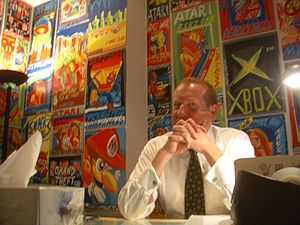Seamus Blackley

Seamus Blackley is a former agent with Creative Artists Agency representing video game creators.
After entering Tufts University to study jazz piano, Blackley switched to study physics and graduated Summa cum Honore en Tesis. As a sophomore, he published his first paper in the Journal of Magnetic Resonance. After college, he studied High Energy Physics at the Fermi National Accelerator Laboratory, until the Superconducting Supercollider project was cancelled in 1993.
Blackley then went to work at Blue Sky Productions, later called Looking Glass Studios. In addition to work there on Ultima Underworld and System Shock, Blackley helped to create the sophisticated physics system in Flight Unlimited. He is mentioned in the Flight Unlimited manual as follows:
As far back as 1992, we started looking for new ways to fly on the PC. Seamus Blackley, a physics expert and experienced pilot, had just been hired on at Looking Glass Technologies, and he was well placed to see where the current simulators fell short of what they could be.
Following the completion of Flight Unlimited in 1995, Blackley planned to use that game's computational fluid dynamics (CFDs) code to create a combat flight simulator called Flight Combat.[1][2][3] However, a new manager at Looking Glass Studios demanded that Blackley instead design a direct sequel to Flight Unlimited. Blackley refused and was fired, leaving the company in late 1995.[2][4] As a result, the second and third games did not have quite as sophisticated physics (though still arguably better than other games of the time), and the series became more civilian in nature.
After Looking Glass, Blackley worked at DreamWorks Interactive as executive producer of Jurassic Park: Trespasser, a physics-rich game published in 1998 (one of the most notorious failures in PC gaming history).
In February 1999, Blackley joined Microsoft. Originally hired to work on DirectX, he co-wrote the initial Xbox proposal, and helped assemble the team that designed and built the device. He then promoted the Xbox to game developers around the world.
Blackley left Microsoft in 2002 to co-found Capital Entertainment Group with former Microsoft co-worker Kevin Bachus after his time developing the Xbox.[5] CEG aimed to reform the financing models available in the game industry, following the Hollywood studio model, to provide more flexibility and creative control to game makers, and loosen the grip publishers had on control of the game industry. CEG was unable to complete a game before folding in 2004.
Currently, Blackley represents video game developers at the Creative Artists Agency, evolving the position of video games within the entertainment industry.
In 2007, Blackley received the P.T. Barnum Award from Tufts University for his exceptional work in the field of media and entertainment.
As of May 2011, Blackley is no longer an agent at Creative Artists Agency.
References
- ↑ Yee, Bernie (March 1995). "Through the Looking Glass". PC Gamer US 2 (3): pp. 62, 63, 65, 67, 69.
- ↑ 2.0 2.1 Takahashi, Dean (April 23, 2002). Opening the Xbox: Inside Microsoft's Plan to Unleash an Entertainment Revolution. Prima Lifestyle. ISBN 0-7615-3708-2.
- ↑ Staff (June 7, 1995). "Looking Glass Technologies Ships Flight Unlimited Worldwide". PR Newswire.
- ↑ Laprad, David (September 8, 1998). "The Evolution of the Prehistoric Beast: An Interview with Trespasser Project Leader Seamus Blackley". Adrenaline Vault. Archived from the original on December 5, 1998.
- ↑ "Seamus Blackley on starting CEG". frictionlessinsight.com.
External links
| Wikimedia Commons has media related to Seamus Blackley. |
- Seamus Blackley's game credits on MobyGames
- Seamus Blackley Speech at DICE '03
- 2003 CEG Interview
- 2001 Xbox-related Interview
- 1999 Gamasutra Post-Mortem on Trespasser
- Association for Computing Machinery Video Interview with Seamus Blackley
| ||||||||||||||||||||||||||||||||||||||